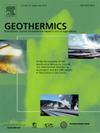Effect of temperature paths on the time-dependent isotropic consolidation behavior of lateritic clay
IF 3.5
2区 工程技术
Q3 ENERGY & FUELS
引用次数: 0
Abstract
The long-term compression behavior of clay is significantly affected by temperature paths. However, most studies on temperature paths focus on short-term changes in volume and pore pressure, with limited research on how temperature paths affect soil secondary consolidation characteristics. To experimentally investigate the time-dependent compression behavior of lateritic clay under different temperature paths, a series of temperature-controlled isotropic consolidation tests from 5 to 50 °C were conducted with consideration of heating/cooling rate and thermal cycle paths. The results indicate that the accumulation of thermal-induced pore water pressure increases with the rate of temperature variations, but a faster rate leads to smaller volumetric changes. Moreover, thermal cycling does not cause irreversible thermoplastic volumetric strain with a suitable heating/cooling rate, and the cycle paths do not influence this outcome. Furthermore, the creep rate of heated samples increases significantly, and the heating/cooling rate also affects the creep rate: a slower heating rate results in a faster creep rate. Additionally, the creep behavior ceased after the thermal cycle, and it appears that the thermal cycle paths have no effect on the creep rate. Finally, this study summarizes the mechanism of the influence of temperature on the creep behavior of clay, and reasonable explanations are proposed for the thermo-mechanical behavior caused by different temperature paths.
温度路径对红土粘土随时间各向同性固结行为的影响
温度路径对粘土的长期压缩性能有显著影响。然而,对温度路径的研究大多集中在体积和孔隙压力的短期变化上,对温度路径对土体二次固结特性的影响研究较少。为研究红土粘土在不同温度路径下的时间依赖压缩特性,在5 ~ 50℃范围内进行了一系列考虑加热/冷却速率和热循环路径的温控各向同性固结试验。结果表明:热致孔隙水压力积累随温度变化速率的增大而增大,但温度变化速率越快,孔隙水体积变化越小;此外,在适当的加热/冷却速率下,热循环不会引起不可逆的热塑性体积应变,并且循环路径不会影响这一结果。此外,加热后试样的蠕变速率显著增加,加热/冷却速率也影响蠕变速率:加热速率越慢,蠕变速率越快。此外,热循环后蠕变行为停止,热循环路径对蠕变速率没有影响。最后,总结了温度对粘土蠕变行为的影响机理,并对不同温度路径引起的热-力学行为提出了合理的解释。
本文章由计算机程序翻译,如有差异,请以英文原文为准。
求助全文
约1分钟内获得全文
求助全文
来源期刊

Geothermics
工程技术-地球科学综合
CiteScore
7.70
自引率
15.40%
发文量
237
审稿时长
4.5 months
期刊介绍:
Geothermics is an international journal devoted to the research and development of geothermal energy. The International Board of Editors of Geothermics, which comprises specialists in the various aspects of geothermal resources, exploration and development, guarantees the balanced, comprehensive view of scientific and technological developments in this promising energy field.
It promulgates the state of the art and science of geothermal energy, its exploration and exploitation through a regular exchange of information from all parts of the world. The journal publishes articles dealing with the theory, exploration techniques and all aspects of the utilization of geothermal resources. Geothermics serves as the scientific house, or exchange medium, through which the growing community of geothermal specialists can provide and receive information.
 求助内容:
求助内容: 应助结果提醒方式:
应助结果提醒方式:


